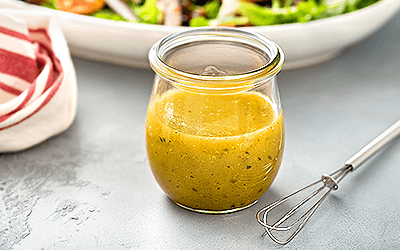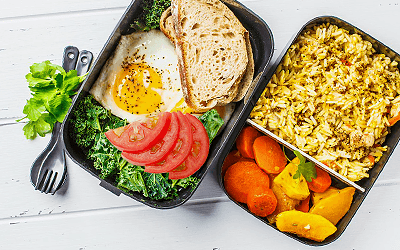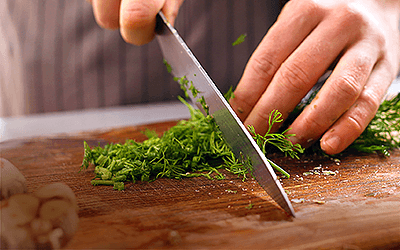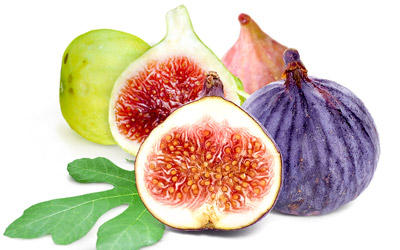Thought to have originated from parts of Asia, the Mediterranean region, and North Africa, cilantro – also known as coriander – has a long history of consumption that stretches back millennia. It is currently cultivated throughout the globe, serving an important role in culinary traditions. Meanwhile, modern science has uncovered the healing potential of this aromatic, citrusy herb.
Cilantro Medicinal Properties
- Medicinal action Antimicrobial, Anxiolytic
- Key constituents Petroselinic acid, linalool
- Ways to use Capsules, Hot infusions/tisanes, Liquid extracts, Food, Freshly ground, Juiced, Tincture, Poultice, Powder, Essential oil, Dried
- Medicinal rating (3) Reasonably useful plant
- Safety ranking Safe
Health Benefits of Cilantro
The word 'cilantro' usually refers to the leaves of Coriandrum sativum (fresh or dried), while 'coriander' is mostly applied to the seeds of the plant, which are often used as a spice. Nevertheless, both terms are frequently used interchangeably in different countries.
Cilantro, also known as coriander (mostly for its seeds), is widely considered a culinary herb, and it has been consumed as such for centuries. However, a deeper look at traditional healing systems reveals that cilantro is also used for treating a variety of illnesses. Some of these folk uses have been investigated by modern science, revealing potential applications. Among the main cilantro's benefits for human health are the following:
Treating and preventing infections. Cilantro is a powerful antimicrobial agent, particularly useful for treating bacterial, fungal, and yeast infections.
- Reducing anxiety and inducing restful sleep. Coriander seeds are particularly rich in essential oils that have a powerful effect on brain activity, inducing calming and sedating effects.
Cilantro has been traditionally used as a chelating agent, thought to remove heavy metals from the body and prevent food poisoning. This herb is also known to reduce blood sugar and promote cardiovascular health by lowering blood pressure and cholesterol.
How It Works
While the major constituents in the cilantro leaf oil are aromatic acids, coriander seed oil is particularly high in petroselinic acid and linalool, geranyl acetate, and γ-terpinene.1
The main bioactive compounds responsible for cilantro's health benefits are petroselinic acid, and linalool.
Petroselinic acid makes as much as 85% of the total fatty acid content of the coriander seed. This unique compound has displayed strong antimicrobial actions against many bacterial strains, yeast, and fungus. The essential oil from Coriandrum sativum has been shown effective against Candida yeast infections.2
On the other hand, linalool is an important terpene in cilantro as well as in many other herbs and a major component of essential oils. It has been shown to have powerful antioxidant, antimicrobial, and anti-inflammatory properties, but it also works on the central nervous system, reducing anxiety and inducing sleep. Linalool interacts with a neurotransmitter called Gamma-amino butyric acid (GABA), which works by regulating neural activity, causing relaxing effects that have been linked to improvements in mood disorders, such as anxiety and depression.3,4
A STUDY SUGGESTED THAT CORIANDER SEEDS' ESSENTIAL OIL INDUCES A SEDATIVE EFFECT SIMILAR TO THAT OF DIAZEPAM.5,6
Other herbs with antimicrobial and anti-fungal properties are garlic and thyme, whereas lemon balm and valerian have been traditionally used for reducing anxiety and as sleeping aids.
Cilantro Cautions
Both cilantro and coriander seeds are considered safe in culinary amounts. However, inhalation and ingestion of this aromatic herb may cause allergic reactions in sensitive people; symptoms include swelling inside the mouth and nose, difficulty breathing, and hives.
Likewise, high amounts of vitamin K in cilantro may hinder the actions of anticoagulants, so people with cardiovascular problems should consult a doctor before taking Coriandrum sativum in medicinal doses.

Cilantro Nutrition
As a culinary herb, cilantro not only provides unique flavor and medicinal properties, but also a wide range of nutrients and dietary fiber.
The most abundant mineral in cilantro leaves is cooper, which is essential for the production and transport of red blood cells as well as for proper iron absorption. Cilantro is also rich in potassium, which helps with fluid balance in the human body and blood pressure control, and manganese, necessary for strong bones and proper wound healing. Additionally, this herb is a good source of iron for maintaining healthy hemoglobin levels, thus preventing anemia.
Cilantro is an outstanding source of vitamin K (phylloquinone), which plays a role in the production of many proteins that are crucial for blood clotting and healthy bones. 100 grams of fresh cilantro leaves provide more than twice the recommended daily intake for this fat-soluble nutrient.
Other important vitamin that cilantro provides in generous amounts is vitamin C (ascorbic acid), necessary for iron absorption as well as for the biosynthesis of collagen, L-carnitine, and certain neurotransmitters. These cilantro's benefits for skin are complemented by high levels of vitamin A, essential for tissue regeneration and eyes health. On the other hand, vitamin E (alpha-tocopherol) is a powerful antioxidant that stops the production of harmful free radicals, thus preventing vision loss, vascular problems, and other age-related chronic conditions. Additionally, good amounts of vitamin B9 (folate) in cilantro ensure red and white blood cells production for a strong immune system, help transform carbohydrates into energy, and are crucial for DNA and RNA production.
100 GRAMS OF FRESH CILANTRO LEAVES PROVIDE ONLY 23 CALORIES, WHICH ARE MAINLY COMPOSED OF DIETARY FIBER (11% DV) AND PROTEIN (4% DV).
How to Consume Cilantro
- Edible parts Leaves, Seed, Stem
- Edible uses Condiment
- Taste Aromatic, Earthy, Tangy
Natural forms
Fresh. The green leaves of cilantro are a staple in local cuisine in China, Mexico, South America, India, and Southeast Asia, adding a refreshing, citrusy flavor to many dishes.
Dried. Once dried, both cilantro leaves and coriander seeds are popularly used in culinary preparations, offering a longer shelf life.
Powder. Coriander seeds and cilantro leaves are often ground and used as a spice, long preserving their medicinal properties and flavor.
Poultice. Crushed coriander seeds are a popular folk remedy for a variety of illnesses, including joint pain, insect bites, and superficial wounds.
Infusion. A warm infusion of cilantro leaves or coriander seeds can help relax the nervous system, reducing anxiety and inducing restful sleep. A cup of coriander tea can also help with headaches, mouth ulcers, and indigestion.
DUE TO ITS DETOXIFYING PROPERTIES, IT IS THOUGHT THAT DRINKING CILANTRO JUICE IN THE MORNING MAY BOOST METABOLISM AND PROMOTE WEIGHT LOSS.
Herbal Remedies & Supplements
Tincture. A few drops of cilantro tincture diluted in a glass of water can be effective in relieving digestive ailments, like stomach aches, flatulence, and constipation. It helps improve blood circulation and detoxify the body from heavy metals.
Essential oil. Coriander oil, extracted from the seeds, is thought to be useful for inducing relaxation and deep sleep, relieving migraines, and reducing joint pain when applied externally. It can also aid digestion when diluted in water and consumed orally.
Capsules. Coriander seeds can be taken pulverized in capsules, which provides the exact dose of active compounds per day. Coriander capsules are promoted for smooth digestion, blood sugar balance, anxiety relief, and even weight management.
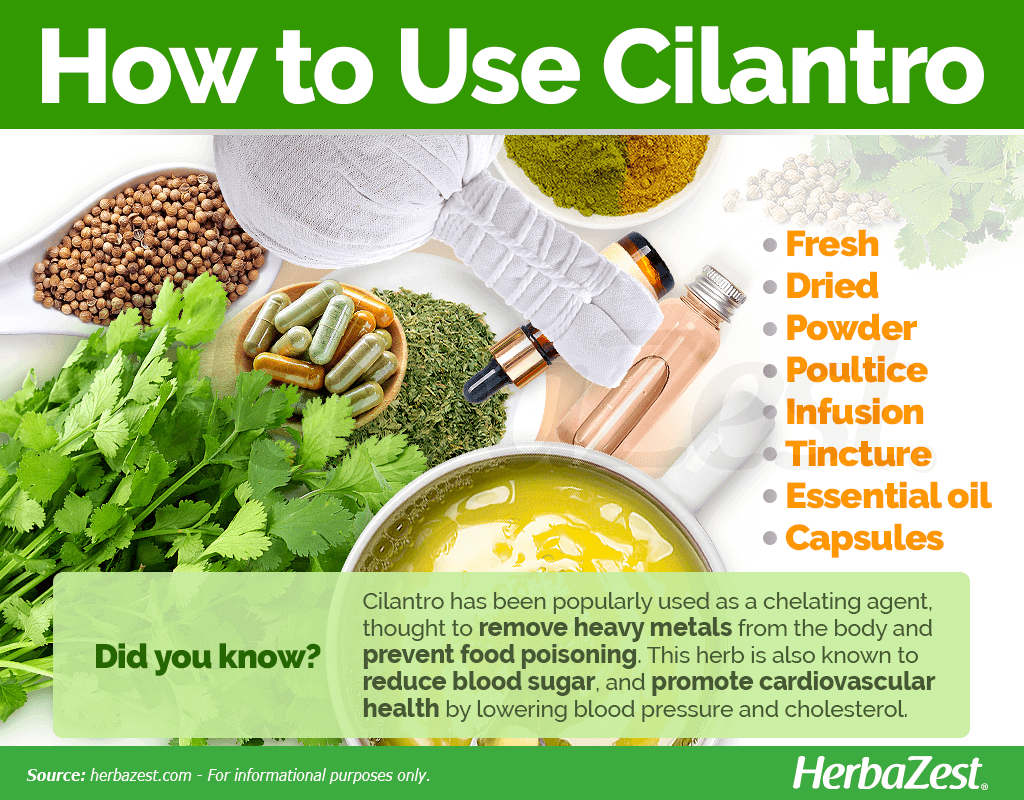
Growing
- Life cycle Annual
- Harvested parts Flowers, Seeds, Leaves, Stem
- Light requirements Full sun, Partial shade
- Soil Medium (loam), Well-drained
- Soil pH 6.6 – 7.3 (Neutral), 7.4 – 7.8 (Slightly alkaline)
- Growing habitat Cool temperate regions, Warm climates
- USDA Plant Hardiness Zones 2a, 2b, 3a, 3b, 4a, 4b, 5a, 5b, 6a, 6b, 7a, 7b, 8a, 8b, 9a, 9b, 10a, 10b, 11a, 11b, 12a, 12b
- Pre-germination seed treatment None
- Planting time Early spring, Right after last frost
- Plant spacing average 0.1 m (0.30 ft)
- Growing time 120 days
- Potential insect pests Aphids, Armyworms, Cabbage loopers
- Potential diseases Bacterial leaf spot
For home gardeners, sowing seeds of cilantro every 3-4 weeks will guarantee a constant supply of fresh leaves.
Cilantro is an annual herb, mostly grown for its seeds, known as coriander. It can grow up to 20 inches (50 cm) and can easily adapt to a variety of environments; however, this cool-season crop thrives under some specific conditions of soil, water, light exposure, and temperature.
Growing Guidelines
Cilantro is most commonly propagated from seeds, and it grows better in loamy soils with good drainage and a pH range of 6.5 to 7.5.
The cilantro plant likes cool environments, with plenty of direct sunlight or partial shade. It thrives in temperatures between 50-85°F (10-29°C), but it can survive temperatures as low as 10°F (-12°C).
The best thing about cilantro is that it can be grown both outdoors and indoors in a container placed in a sunny spot, like a windowsill.
The seeds of cilantro should be planted at a depth of 1/4 to ½ inches (0.6-1.27 cm), with a spacing of 2 inches (5 cm) between plants, in rows 12 to 15 inches (31-38 cm) apart.
It is crucial to keep the soil moist during the germinating process, while being careful not to overwater it. Once the cilantro plant is established, it will not need much water.
In cool, temperate climates, the seeds of cilantro take 1-2 weeks to germinate, and the plant can be harvested after 120 days. However, in warm regions, cilantro plants bloom 4-6 weeks after planting.
The best time to plant cilantro is after the last frost, or the first days of spring. The main harvests are between March and mid-November, whereas winter crops are harvested from November to March.
The main disease that affects cilantro is bacterial leaf spot. This crop is also attacked by some plagues, such as beet armyworms, cabbage loopers, and green peach aphids.
Additional Information
- Other uses Cosmetics, Fuel, Perfume, Repellent
Plant Biology
Cilantro (Coriandrum sativum L.) is a cold season crop, soft and hairless, with leaves that are compound and variable in shape, and white to pale pink flowers that bloom in clusters of 2 inches (5 cm) across. The fruit of cilantro is a globular dry schizocarp, commonly known as coriander seed.
Classification
With small flowers and rounded seeds, Coriandrum sativum is a species that belongs to the Apiaceae family, mostly comprised of aromatic plants, with 3700 species spread over 434 genera. This botanical family includes mostly temperate crops with umbellate inflorescences, such as anise (Pimpinella anisum), angelica (Angelica archangelica), arracacha (Arracacia xanthorrhiza), carrot (Daucus carota), celery (Apium graveolens), dill (Anethum graveolens), fennel (Foeniculum vulgare), osha (Ligusticum porteri), and parsley (Petroselinum crispum).
Species and varieties of cilantro
The Coriandrum genus includes only two species, Coriandrum sativum and Coriandrum tordylum. Both are very similar, with the latter being a wild species native to parts of Turkey and Lebanon. Many varieties of Coriandrum are cultivated in different parts of the world.
For commercial purposes, coriander seeds are often categorized into three groups: East European (small seeds, high oil content, sweet aromatic flavor with slight lemon notes), North African and Spanish (large seeds, low oil content, and sweet aromatic flavor), and Indian (oval seeds with a distinguished, slightly bitter taste profile).
History of Cilantro
Native to the Mediterranean basin, south-western parts of Asia, and North Africa, it is thought that cilantro was first cultivated as a spice crop in the Asian side of Turkey (formerly known as Anatolia), from where it quickly spread to Egypt, Armenia, southeastern Europe, and southern Russia.
An Egyptian papyrus, dating back to 2500 to 1550 BCE, describes cilantro as a medicinal plant. The herb is also listed as an ingredient in a stew on clay tablets found in Mesopotamia. Cilantro has been cultivated for millennia in India and China and introduced into Mexico and Peru by the Spaniards.
CORIANDER SEEDS HAVE BEEN FOUND IN THE TOMB OF TUTANKAMUN AND THE ASSYRIAN KING NIMRUD.
Popular Beliefs
Curiously, 'manna' is likened to coriander seeds in the Bible, in order to describe the appearance of the mythical food that fell from the sky to feed the Israelites during their exodus from Egypt. According to an ancient Chinese belief, cilantro leaves and seeds confer immortality to those who consume them.
Economic Data
The main producers of cilantro are India, China, the former Soviet Union, Mexico, South America, Central America, and the Caribbean. In the United States, cilantro is commercially cultivated across the West Coast, mostly in California, but because of high demand, this country imports large amounts of this aromatic herb.
Other Uses of Cilantro
Gardening. Cilantro is not only cultivated for its flavor and medicinal properties, but also as a plant companion and pest control agent. Cilantro flowers attract beneficial insects, which pollinate other plants and destroy harmful bugs.
Fuel. Due to the high stability of their essential oils, coriander seeds are being evaluated as an alternative source of biodiesel.
Perfumery. Thanks to its sweet, spicy characteristics as well as soft, woody, and peppery nuances, coriander essential oil is often used as an undertone in many commercial fragrances.
Cilantro has become a common ingredient and spice around the world, so its rich history and health benefits are often overlooked. However, this humble herb is a powerhouse of medicinal and nutritional benefits, and it deserves a rightful place as part of a balanced diet and herbal cabinets.
Sources
- Biomass and Bioenergy, Coriander seed oil methyl esters as biodiesel fuel. 2010
- Colorado State University, Cilantro
- Coriander
- Fitoterapia, Coriander (Coriandrum sativum L.) and its bioactive constituents. 2015
- Food Research International, Coriander (Coriandrum sativum): A promising functional food toward the well-being. 2018
- Heritage Garden, Cilantro (Coriandrum sativum)
- Molecules, Characterization of French Coriander Oil as Source of Petroselinic Acid. 2016
- Natural Product Communications, Linalool – A Review of a Biologically Active Compound of Commercial Importance. 2008
- North Carolina State University, Extension Gardener. Coriandrum sativum
- The Encyclopedia of Healing Foods, p. 479
- The Way of Ayurvedic Herbs, p. 125
- University of Iowa, Coriander and Cilantro
- Phytotherapy Research, Coriander (Coriandrum sativum L.): a potential source of high-value components for functional foods and nutraceuticals--a review. 2013
Footnotes:
- Bangladesh Journal of Pharmacology. (2009). Chemical composition of leaf and seed essential oil of Coriandrum sativum L. from Bangladesh. Retrieved March 18, 2021, from: http://bdpsjournal.org/index.php/bjp/article/view/395
- Food Chemistry. (2010). Antimicrobial potential of Coriandrum sativum L. against different Candida species in vitro. Retrieved March 18, 2021, from: https://www.sciencedirect.com/science/article/abs/pii/S030881460900541X
- Colloids and Surfaces B: Biointerfaces. (2018). Linalool bioactive properties and potential applicability in drug delivery systems. Retrieved March 18, 2021, from: https://www.sciencedirect.com/science/article/abs/pii/S0927776518305253
- Frontiers in Chemistry. (2017). Metabolic Products of Linalool and Modulation of GABAA Receptors. Retrieved March 18, 2021, from: https://www.ncbi.nlm.nih.gov/pmc/articles/PMC5478857/
- Pharmaceutical Biology. (2016). Sedative effect of central administration of Coriandrum sativum essential oil and its major component linalool in neonatal chicks. Retrieved March 18, 2021, from: https://pubmed.ncbi.nlm.nih.gov/26911626/
- Indian Journal of Pharmacology. (2011). Anti-anxiety activity of Coriandrum sativum assessed using different experimental anxiety models. Retrieved March 18, 2021, from: https://www.ncbi.nlm.nih.gov/pmc/articles/PMC3195130/
